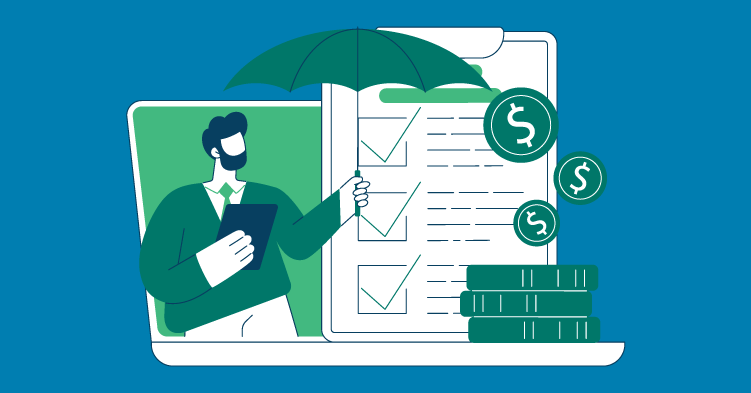Around 37% of Americans can’t cover a $400 emergency expense with cash. When unexpected costs pop up, many people either have to sell something or find a way to borrow the money. Having a financial safety net to fall back on can relieve some of this stress.
A personal line of credit (PLOC) can act as a safety net — but it has many other uses as well. Let’s explore some common uses of personal lines of credit and how they can help borrowers in different situations.
1. Emergency Expenses
When you have a line of credit available, emergency expenses can be less stressful since you know you have the funds available to borrow. Instead of scrambling to apply for an emergency personal loan or running up a credit card bill, you can draw the amount you need from your line of credit. Emergency expenses might include:
Car repairs. If you get in an accident or your car breaks down, the repairs can be expensive. Having your car to get to work, or yourself or your kids to school, is important. A personal line of credit used as an auto repair loan can help you cover the cost.
Home repair. Having somewhere safe and comfortable to live is a priority. Damage like leaks, faulty heating or cooling systems or broken windows can pose a health risk. A line of credit can help you get the repairs you need to make your home livable.
Travel emergencies. If you need to travel for an emergency but don’t have the cash on hand, a line of credit can help you with funds to get you where you need to be.
Replacing stolen or damaged items. Things like a phone or laptop can be essential to everyday life, but they’re often expensive to replace if they’re damaged or stolen. A personal line of credit can help.
2. Cash Flow Management
Managing your personal finances can mean juggling due dates and cash flow. The day a bill is due doesn’t always line up with when you get paid. A personal line of credit can help in scenarios such as:
Paying a bill to avoid service disruption. Keep your essential utilities running, even if you’re still waiting for your paycheck.
Covering rent or mortgage. Ensure you have a roof over your head without worrying about the timing of the payments.
Avoiding a late fee or bounced check. Missing payments can damage a good credit history — and late fees can add up quickly.
Covering transportation costs to get to work or school. A personal line of credit can help ensure you have the cash you need to get to work or school, even if your checking account balance is running low.
3. Large Purchases
While saving up to make large purchases is always ideal, sometimes life has other plans. A personal line of credit can help you cover the cost of essential expensive purchases.
Household appliances. Whether it’s safely storing food, keeping your clothing clean or any other essential task, appliances ensure that your home runs smoothly.
Moving costs. Renting a truck, putting down a security deposit, purchasing items needed for your new home, and other expenses that come with moving can add up quickly.
4. Home Renovations
Whether it’s to increase your home’s value or repair aging areas, home improvements can be a significant expense. If you own your home, you may want to consider a home equity line of credit (HELOC), which allows you to take out a personal line of credit based on the value of your home. A personal line of credit is flexible, making it a great financial tool to use for home renovations. Here’s how it can help:
Planning your projects. Unlike traditional loans that provide a lump sum of money, a line of credit allows you to draw funds as needed. This means you can take on one project at a time, managing renovations in stages without straining your finances.
Flexible budgeting. With a personal line of credit, you only have to draw the amount you need. So, if you budgeted $15,000 for a project but only spent $10,000, you won’t be responsible for paying back the money you didn’t borrow. Plus, you only pay interest on the amount you borrow.
Seizing timely opportunities. Sometimes, the best deals on materials or contractor services are time-sensitive. Having immediate access to funds through a line of credit ensures you don’t miss out on discounted rates or promotional offers.
Covering unexpected costs. Renovations often come with unforeseen expenses. This could be because of hidden damages or a decision to upgrade materials. A line of credit can help ensure that these surprises don’t stop the project.
5. Recurring Expenses
You may have some recurring expenses that don’t fit into your normal monthly budget. For example, getting educational supplies such as textbooks at the start of the semester, services that are billed annually, tax obligations or bi-annual insurance premiums. A line of credit can help you take care of these expenses when they arise.
What Is a Personal Line of Credit?
A personal line of credit is a flexible financial tool that allows you to draw a certain amount of money, up to a set credit limit, to cover various expenses. You’ll then typically repay the amount you’ve borrowed in bi-weekly or monthly payments. Most lines of credit are revolving, so the funds become available to borrow again as you repay.
How Does a Personal Line of Credit Work?
You can apply for a revolving line of credit through financial institutions like a bank, credit union or online lender. Banks and credit unions may have stricter approval standards than an alternative lender, and they often will run a hard credit check to determine approval. Alternative lenders may have less strict requirements, but they will also likely come with higher interest rates. An excellent credit score can help you get better terms and lower interest rates.
If you’re approved, you’ll get a credit limit that you can borrow from. You can borrow the amount you need from your available credit, when you need it. With a line of credit you’ll be charged interest only on the amount you borrow, plus whatever fees were outlined in your agreement. You’ll have a set repayment period in which you’ll need to repay the amount you borrowed — but you don’t have to wait to borrow more from your available credit. As you repay, the money becomes available to borrow again (similar to a credit card, which is another form of revolving credit.)
The loan terms will be set by the lender, but be sure to do your research. You can find secured and unsecured lines of credit. Plus, interest rates will vary from lender to lender and may depend on your creditworthiness. Lines of credit also often come with monthly or annual fees, such as a maintenance fee, and you can be charged a withdrawal fee as well.
How Does a Personal Line of Credit Compare to Other Types of Borrowing?
Credit card. A line of credit and a credit card are both forms of revolving credit, but there are some big differences — one being that credit cards can not be used in place of cash. A credit card can be good for managing everyday expenses and cash flow.
Installment loans. Installment loans are another type of credit where you’ll receive an upfront lump sum of cash that you’ll repay over a period of time. An installment loan may be a good option if you have a large one-time expense.
How Do I Know if a Personal Line of Credit Is Right for Me?
Whether or not a personal line of credit is the right financing option for you will ultimately depend on your financial situation and personal needs.
Evaluate your financial needs. If you have recurring expenses and want a flexible borrowing option that will allow you to draw multiple times, or you want to have an available source of cash for when emergencies arise, a line of credit could be a good option.
Understand your spending habits. A line of credit can be tempting to use as an extra source of cash. Be sure to use it wisely as over-reliance on a line of credit can lead to extra debt.
Think about repayment. The flexibility of a line of credit can be useful in managing cash flow, but be sure to have a plan for repayment. Also, keep in mind that not all lines of credit have a fixed interest rate. If your line of credit has a variable interest rate, be sure you can handle the fluctuations.
Be aware of the fees. Many lines of credit have maintenance fees, origination fees or withdrawal fees, be sure you know what you’ll be paying before you sign an agreement.
Watch your credit score. A well managed line of credit, with timely repayments and a low utilization rate can help you build your credit history. But missed payments and high credit utilization can negatively impact your credit history.
Consider other options. If you have a poor credit history, you may have to deal with higher interest rates — making a line of credit an expensive form of borrowing. Consider if your family or friends can help, or if you can save up if it’s not an emergency expense.






